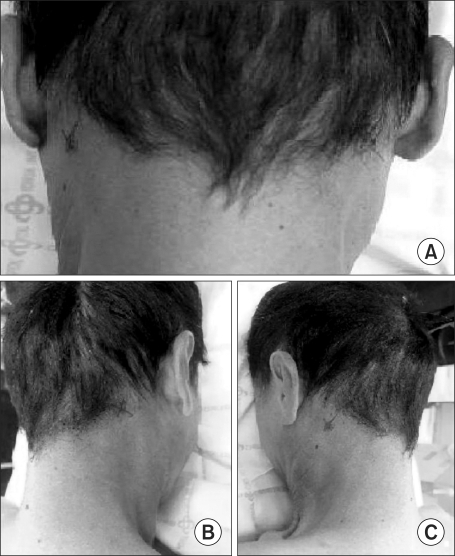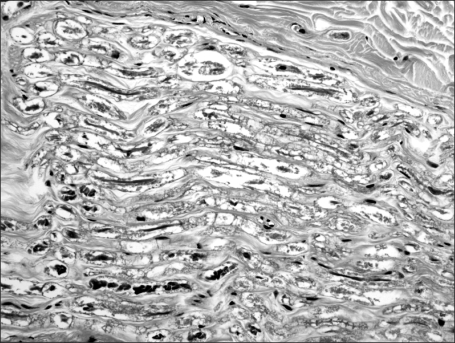Korean J Pain.
2010 Mar;23(1):82-87.
Fluoroscopy and Sonographic Guided Injection of Obliquus Capitis Inferior Muscle in an Intractable Occipital Neuralgia
- Affiliations
-
- 1Department of Anesthesiology and Pain Medicine, Konkuk University School of Medicine, Seoul, Korea. zxcv456@hanmail.net
- 2Department of Neurosurgery, Konkuk University School of Medicine, Seoul, Korea.
- 3Department of Pathology, Konkuk University School of Medicine, Seoul, Korea.
Abstract
- Occipital neuralgia is a form of headache that involves the posterior occiput in the greater or lesser occipital nerve distribution. Pain can be severe and persistent with conservative treatment. We present a case of intractable occipital neuralgia that conventional therapeutic modalities failed to ameliorate. We speculate that, in this case, the cause of headache could be the greater occipital nerve entrapment by the obliquus capitis inferior muscle. After steroid and local anesthetic injection into obliquus capitis inferior muscles under fluoroscopic and sonographic guidance, the visual analogue scale was decreased from 9-10/10 to 1-2/10 for 2-3 weeks. The patient eventually got both greater occipital neurectomy and partial resection of obliquus capitis inferior muscles due to the short term effect of the injection. The successful steroid and local anesthetic injection for this occipital neuralgia shows that the refractory headache was caused by entrapment of greater occipital nerves by obliquus capitis inferior muscles.
Figure
Reference
-
1. Andrychowski J, Czernicki Z, Netczuk T, Taraszewska A, Dabrowski P, Rakasz L, et al. Occipital neuralgia: possible failure of surgical treatment-case report. Folia Neuropathol. 2009; 47:69–74. PMID: 19353436.2. Hashiguchi A, Mimata C, Ichimura H, Kuratsu J. Occipital neuralgia as a presenting symptom of cervicomedullary dural arteriovenous fistula. Headache. 2007; 47:1095–1097. PMID: 17635604.
Article3. Bruti G, Mostardini C, Pierallini A, Villani V, Modini C, Cerbo R. Neurovascular headache and occipital neuralgia secondary to bleeding of bulbocervical cavernoma. Cephalalgia. 2007; 27:1074–1079. PMID: 17645754.
Article4. Bloom KK, Ellen J, Kaye D. Occipital neuralgia and twelfth nerve palsy from a chondromyxoid fibroma. J Ky Med Assoc. 2004; 102:255–258. PMID: 15216723.5. Garza I. Craniocervical junction schwannoma mimicking occipital neuralgia. Headache. 2007; 47:1204–1205. PMID: 17883527.
Article6. Hardy D. Relief of pain in acute herpes zoster by nerve blocks and possible prevention of post-herpetic neuralgia. Can J Anaesth. 2005; 52:186–190. PMID: 15684261.
Article7. Kihara T, Shimohama S. Occipital neuralgia evoked by facial herpes zoster infection. Headache. 2006; 46:1590–1591. PMID: 17115995.
Article8. Mourouzis C, Saranteas T, Rallis G, Anagnostopoulou S, Tesseromatis C. Occipital neuralgia secondary to respiratory tract infection. J Orofac Pain. 2005; 19:261–264. PMID: 16106720.
Article9. Nikakis P, Koutsis G, Potagas C, Mandellos D, Sfagos C. Occipital neuralgia as an isolated symptom of C2 myelitis. Headache. 2006; 46:1304–1306. PMID: 16942479.
Article10. Stechison MT, Mullin BB. Surgical treatment of greater occipital neuralgia: an appraisal of strategies. Acta Neurochir (Wien). 1994; 131:236–240. PMID: 7754828.
Article11. Vital JM, Grenier F, Dautheribes M, Baspeyre H, Lavignolle B, Senegas J. An anatomic and dynamic study of the greater occipital nerve (n. of Arnold). Applications to the treatment of Arnold's neuralgia. Surg Radiol Anat. 1989; 11:205–210. PMID: 2588096.
Article12. Kastler B, Boulahdour Z, Aubry S, Fergane B, Patay Z. Kastler B, editor. Arnold's neuralgia. Interventional radiology in pain treatment. 2007. Berlin Heidelberg: Springer;p. 71–80.
Article13. Hunter CR, Mayfield FH. Role of the upper cervical roots in the production of pain in the head. Am J Surg. 1949; 78:743–751. PMID: 15391183.
Article15. Jankiewicz JJ, Hennrikus WL, Houkom JA. The appearance of the piriformis muscle syndrome in computed tomography and magnetic resonance imaging. A case report and review of the literature. Clin Orthop Relat Res. 1991; 262:205–209. PMID: 1984918.16. Bogduk N. The anatomy of occipital neuralgia. Clin Exp Neurol. 1981; 17:167–184. PMID: 7346198.
- Full Text Links
- Actions
-
Cited
- CITED
-
- Close
- Share
- Similar articles
-
- Intractable Occipital Neuralgia Caused by an Entrapment in the Semispinalis Capitis
- Essential Clinical Tips about Ultrasound Guided Cervical Intervention
- Ultrasound-Guided Greater Occipital Nerve Block for Primary Headache: Comparison of Two Techniques by Anatomical Injection Site
- Nerve Block for Treatment of Tienchu Syndrome and Occipital Neuralgia
- Feasibility of Ultrasound Guided Atlanto-occipital Joint Injection






